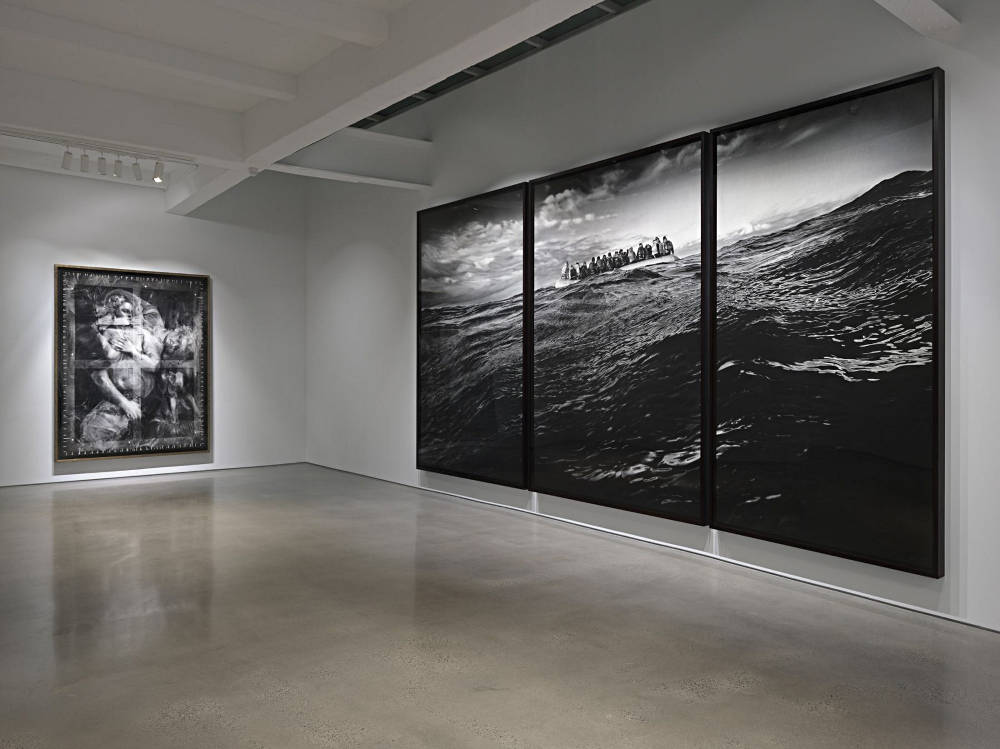
Looking at the career of the artist Robert Longo can be a philosophical meditation on style. Style, as opposed to stylization, is a key to understanding Longo’s importance as an artist, both at the beginning of his career with the Men in Cities drawings, through his large charcoal drawings of guns, to his blue-chip Abstract Expressionist paintings, and into this recent, powerful exhibition at Metro Pictures.
A lot of art that we place in the category "Eighties Art" (see this year's Whitney exhibition, a perfect collection of specimens) rested heavily on stylization, not style. Much of this type of work was paintings that came with pre-fab "movements," object-sculptures allegedly imbued with some post-modern sensibilities, and, most especially, the adding of "neo" before any historical art movement to create a new category. At first, Longo’s flailing and falling characters (Longo is heavily influenced by film), dancing or dying in a void, seemed like emblems for museums to use as signifiers for retro shows, in perpetuity. Almost as visually stunning as the Mercedes logo, or the Nike "swoosh."
Looking at these new drawings one gets the sense that this time, maybe, there was no great theme, no overarching concept that suborned the drawings, but rather that each subject presented itself, and one idea connected to the next. The resulting show resembles a book of short stories, rather than a novel, and in tone resembles Jay McInerney more than Richard Price.
In his past exhibitions Longo has presented his drawings (say, the Black Flags, or Guns), direct, confrontational images, in simple direct hangings. Bruce Nauman said that he wanted the viewer to feel hit by a baseball bat when seeing his work; it is exactly the feeling one got at a Longo show. Here, despite the agro title, Longo has chosen imagery from a variety of sources, and ones that visually, at least at first, reveal themselves slowly. In untitled (Teletubbies) (2016), Tinky-Winky, Po, Dipsy, and company gaze blankly, and lovingly, out at us. This must be what we look like from their point of view. From looking out, to looking through. Untitled (x-ray view of Venus with a Mirror, 1555, After Titian) (2016–17) depicts just that -- looking at the vernacular images that we don’t often see [untitled (Riot Cops) 2016] because of their ubiquity in the media. That sense of parsing out the ways we see is pure Johns, and untitled (Nov. 8, 2016) (2016), a flag diptych, might be a sly nod, though Longo's flag is charged with politics, history, and power in a way that Johns’s pictures seldom are.
The other imagery in the show -- athletes, Americana (The Statue of Liberty), and a raft of people tossed on stormy waters -- grabs our attention but does not always hold it. Longo simulates in drawing, that most primitive, elemental art form, the way that we are deluged with random images through the media, our phones, our computers…our environment -- our modern, high-tech world.
"I've been dealing with epic images," Longo has said, "and I realized all of a sudden that I grew up in the age of epics." The Pictures Generation, the group Longo was associated with in the early '80s, did indeed grow up under the light of movie screens and flickering cathode ray tubes, the random barrage of information becoming a visual white-noise, making everything we looked at into everything we saw. Longo, like Cindy Sherman and David Salle, directed films in the mid-'90s. It is clear that, though a good director, Longo finds the moment -- the frame -- of a much grander scene and amplifies it through drawing in a way that cinema cannot. When we first encountered Longo's work, it was competing with MTV, Star Wars, and the spectacle of metal bands. What distinguishes Longo’s recent work is that his graphic sensibility has never left, only become more nuanced with age. - Bradley Rubenstein
